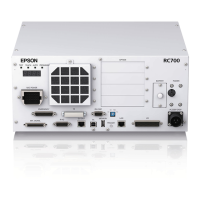Functions 14. I/O Remote Settings
RC700 Series Rev.3 151
14. I/O Remote Settings
This section describes the functions and timings of input and output signals.
The remote functions may be assigned to your standard I/O board(s), expansion I/O board(s),
or fieldbus I/O board(s) to enhance robot system control - either from an operational unit of
your choice or a sequencer.
The remote function is initially assigned to the input 0 to 7 and output 0 to 8.
To accept external remote inputs, assign the remote function and the control device is remote.
The user defines the I/O number that a remote function is assigned to using software
configuration.
For details about communication with external equipment, refer to EPSON RC+ 7.0 User’s
Guide – 12. Remote Control.
CAUTION
■
When using remote I/O, always make sure of the followings. Using the robot
system under unsatisfactory conditions may cause malfunction of the system
and/or safety problems.
- This signal is not safe signal. Do not use this for as a safety function.
- Assign remote functions to inputs/outputs correctly and wire correctly when
setting up remote I/O signals.
- Make sure that the functions correspond to the correct input/output signals
before turning ON the system.
- When verifying the robot system operation, prepare for failures with initial
settings or wiring. If the Manipulator functions unusually by the failures with
initial settings or wiring, press the Emergency Stop switch immediately to stop
the Manipulator.
Remote function is available when virtual I/O is enabled.
When you set up a remote I/O signal, please either keep a written record of the settings or
store the data in a file for later reference.
When you set up a fieldbus I/O signal to the remote function, response depends on the baud
rate of the fieldbus. For details of fieldbus response, refer to the following manual:
Robot Controller option Fieldbus I/O

